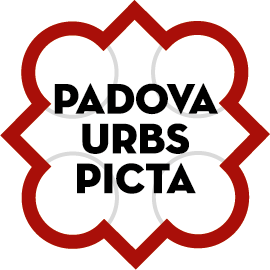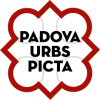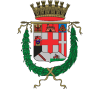This itinerary does not have a fixed route; instead, it thematically links together points in the city that are most significant from a historical point of view. Whichever way you chose to follow it, the whole route lies within the Restricted Traffic Zone and so can easily be covered on foot.
From Paphlagonia to the Age of the Roman Empire
Legend has it that Padua was founded by Antenor, a warrior of the Enetoi from Paphlagonia, mentioned in Homer’s Iliad as allies of Troy in its war against the Greeks. Livy takes up this legend to draw a parallel between the founding of Padua and Rome, which are thus seen as natural allies of each other. In fact, the link between Padua and Rome was particularly significant at a time when both of them had joined together to meet the threat posed by the Gallic tribes to the north. Hence it is fitting that this itinerary starts in Piazza Antenore, where one can find what, until conclusive scientific examination, was long claimed to be the tomb of the city’s mythical founder. In the same piazza you can see further evidence of the circumstances in Padua doing the Roman era. The Ponte San Lorenzo is one of the numerous bridges which at the time crossed the various branches of the rivers Brenta and Bacchiglione that ran through the city, making the transport of goods easy but also posing a significant risk; the frequent flooding of these waterways would, in fact, cause radical changes in the very morphology of the urban territory. At the time of the Roman empire, Padua came after only Rome and Cadiz in importance. It had an Arena for public spectacles, a Circus Maximus and a theatre (later known as Lo Zairo) – all located in the area of the present-day Prato della Valle – as well as flourishing river ports and craft manufactures. In the area that stretches from the Canton del Gallo (the junction of Via San Francesco and Via VIII Febrraro/Via Roma) to Palazzo Moroni, stood the Roman Baths, whilst further along the Listòn, in the area from Piazza Cavour to Piazza Garibaldi, was the Roman Forum. In the latter piazza, the sole column that remains of what must have been an imposing structure stands surmounted by a statue of the ‘Madonna dei Noli’ [Our Lady of the Carters]. The second point in this itinerary is the Roman Arena, or what remains of it after the destruction caused during the Middle Ages and beyond (when the structure was ‘quarried’ for building materials). Alongside the Arena is the entrance of the Eremitani Museum complex, whose collections contain a lot of material dating from the time of the Euganei, the Veneti (said to have arrived here from Paphlagonia) and the Romans; the museum also houses a wealth of material relating to the later history of the city and an important art gallery.
The Eruption of the Visual Arts
No visitor to the city should miss the Scrovegni Chapel, which exemplifies the rebirth of the city after the long decline that had begun with the fall of the Roman empire. That had been a period when the city was raided by the Huns; came under Byzantine rule; witnessed the power clashes between Byzantium and the Goths; and finally was razed to the ground by Agilulf’s Longobards. Of the Paduans who escaped at that time, some took refuge in Monselice; others fled to the islands of the Venetian lagoon, where – together with other refugees – they founded what would ultimately become Venice. The city of Padua itself lay almost totally abandoned for centuries, until the return of the bishop and various monastic communities: first the Benedictines and Augustinians, then the Carmelites and the Franciscans. There followed a period in which the city flourished but faced various difficulties; the medieval Commune became firmly established but was in constant battle with neighbouring cities, all of which were trying to expand. At the same time there were internal struggles between those who supported the temporal power of the Papacy and those who looked to the Holy Roman Emperor. With the foundation of the university, cultural life became more intense, and there was also intense activity in manufacturing, commerce and the embellishment of religious foundations. Commerce brought with it banks, and therefore debts and moneylenders. At the time, charging interest on a loan was considered a mortal sin for a Christian because it involved taking advantage of the misfortune of others. And it was to intercede on behalf of the soul of his moneylender father that Enrico Scrovegni had a chapel built in honour of the Virgin of the Assumption on the site of the Roman Arena. To paint the frescoes in that building, he then commissioned the most revolutionary artist of the day, Giotto di Bondone. Thus the fourteenth century opened in Padua with the city in awe before images that were so real that they took the spectators’ breath away. The early decades of that century also saw the completion of work on the Basilica of St. Anthony, the continuation of work on the “building site of St. Giustina, and the beginning of work on the church of the Eremitani (which stands alongside the site of the Scrovegni Chapel). The Baptistery of the Cathedral had also just been completed, and would itself become home to another artistic marvel: the frescoes by Giusto De’ Menabuoi. After him would arrive Squarcione, from whose studio in Padua would emerge a figure whose achievements far surpassed his own: Andrea Mantegna.
The Struggle for Independence
But to go back to the earlier foundation of the University, one should point out how its presence in the city raised intellectual debate here to such levels that it attracted students and scholars from all over Europe. Careful to nurture relationships with other comparable foundations that were beginning to appear at the time, the University was itself a very open organization. It was the students themselves who shared out the cost of classrooms and materials, and paid the teachers – thus guaranteeing themselves the privilege of learning from some of the best minds of the day. At the same time, the university was open to all, Christians and non-Christians, and (almost) everything was open for discussion. The imperative was to learn and to innovate. And all of this was occurring at the same time as the already-mentioned debate between Guelphs and Ghibellines raged in the city. In such an atmosphere, it was a short step from words to actions (just as it would be 600 years later, when Padua’s students led the rebellion of 1848 against Habsburg rule). For almost 150 years, Padua would-be embroiled in war with first the Dalla Scala of Verona and then the Ezzelini, lords of Romano, until finally Ezzelino II conquered the city in 1237. The government he established would be harsh and repressive, fully reflecting the cruelty of the time, and earned him the nickname “the Terrible”. His family would finally be defeated around 20 years later, and although this unleashed, sometimes violent, struggles between rival families the city continued to grow. Padua was now governed by a Great Council, whose meetings were held in the Palazzo della Ragione (known as ‘Il Salone’), which stands between the city squares known simply as le piazze. It was a location that was, and still is, the hub of daily commerce in Padua; a gathering-place for those whose conversation ranges from the political to the personal. Violent internal rivalries within the city would come to an end with the arrival of the Da Carrara family, which established the conditions of peace and political continuity that enabled Padua to achieve its greatest splendour. It would be Ubertino Carraresi who built the magnificent Carraresi Palace right in the city of the city – a structure of which only a few traces remain today. In 1405 Venice defeated Francesco ‘Novello’ Carraresi and thus conquered Padua, whose fate from then on was linked with that of the Serenissima.












